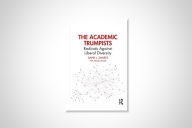You have /5 articles left.
Sign up for a free account or log in.
TAMPA, Fla. -- White privilege -- the concept that whites benefit from structural racism in ways that similarly situated nonwhites don’t -- has been hotly debated among academics for decades. But recent events -- from the riots and protests in Ferguson, Mo., to the closure of a University of Oklahoma fraternity over its racist chants, to this week’s beating of a black University of Virginia student by state police -- have reinvigorated that debate, along with calls for teachers to talk directly with their students about white privilege. (Note: This sentence has been updated from a previous version to reflect that the Virginia incident involved state, not campus, police.)
For professors inclined to answer those calls, just how should they do it, particularly in a writing class? That was the topic of a popular session Thursday at the annual meeting of the Conference on College Composition and Communication. The session was led by Ersula Ore, an assistant professor of writing at Arizona State University who found herself at the center of a debate about police racism on that campus last year, when she was body-slammed by campus police after they stopped her for jaywalking and she refused to show her ID. (Ore is African-American.)
Ore, who has declined to answer questions about her case, citing legal concerns (she is suing the university), didn’t talk about her own experience Thursday. But she offered a historical overview of discussions of white privilege in top writing pedagogy journals. Ore noted a seminal 1998 article by Catherine Prendergast, a professor of English at the University of Illinois at Urbana-Champaign, arguing that race is the “absent presence” in composition studies and advocating the study of whiteness and racial privilege in the field. That argument gave way over the next decade to the notion of teaching empathy as an antiracist strategy, Ore said.
Other speakers discussed their attempts to teach racial empathy. Scott Gage, an assistant professor of rhetoric and composition at Colorado State University at Pueblo, said he taught an upper-level English course on challenging white supremacist memories of lynching. The basis for the 12-week study was an archive of graphic photos of lynchings of blacks in the American South. He said all photos in the archive tended to fit into one of three categories: white mobs attending the lynchings, black victims of lynching hanging from trees and white men posing with the dead. Gage argued that all three formats perpetuated a perverse, “celebratory” narrative about lynching, which he asked his students to correct by creating their own “counternarrative” contributions to the archive.
He showed several examples of student projects, including a digitally rendered portrait of someone grieving for the dead and another showing the face of a child and a lynched body replacing one of the scales of what Gage called a “decaying” Lady Justice. Gage said the project taught students the power of visual rhetoric, and that their attempts to tie lynching to grief and the institutions that enabled it to continue shifted the “politics of public remembrance.” He noted, however, two “problems” with the project: that the new images deserved to be circulated beyond the classroom and that a student might choose to create a more traditional, racist picture. Gage said he didn’t think it was appropriate to censor his students, but that he hoped they would see the assignment’s “ultimate value.”
Asked by an audience member how he avoided becoming sensationalist, Gage said he hoped not to become known as the “white guy presenting black dead bodies every [12] weeks.” He said he supplements graphic but necessary imagery with readings on visual theory, writing exercises and thoughtful discussions.
Earl Brooks, a teaching assistant and graduate student in English at Pennsylvania State University at State College, also works with his students on race and visual rhetoric. He said he once asked them to analyze Toyota Camry ads featuring a black family, identifying the ads’ target audience. He said the students were more interested in discussing the color of the sky than the skin color of the models -- suggesting that they aren’t particularly comfortable or used to discussing race.
“For many students, it’s easy to avoid these topics,” he said.
Brooks is also working on a project on race in the writing classroom, through the lens of Trayvon Martin case. He said he asks students to analyze some of the language and rhetoric about Martin, an unarmed teenager, during the trial of his killer, George Zimmerman, for example. Brooks said it’s challenging to engage students in discussions about race -- still “taboo” to many -- but that it’s helpful if he gives students a “toolbox” of racial and rhetorical terms with which to discuss the case.
David Green, an assistant professor of English at Howard University, raised similar points in a discussion of his work on rhetoric and narrative in the case of the so-called Central Park Five, a group of black and Hispanic teenagers charged with and convicted of brutally raping a female jogger in 1989, only to have their convictions vacated years later amid fresh evidence in the case. He said his analysis of that case involves a seeking “a deeper understanding of African-American discourse and larger questions about racial social justice.”
Responding to her colleagues’ thoughts, Ore asked if she thought their work posed political career risks, especially considering their junior faculty status. “You continually point this out, and the risk is, you become a target,” she said, referencing the conference’s overall theme, “Risk and Reward.” She added, “That’s where my head is at.”
Gage said he thought he was taking the biggest risk not with his peers or administrators but with his students, making himself vulnerable in being as open as possible in class discussions. Green said he thought being “disruptive” was an inherent part of this kind of pedagogy, while Brooks said he sometimes talks to students about his own male privilege. For example, he said, he doesn’t worry about walking alone through campus at night, as a woman might. Emphasizing the pedagogy of empathy, he said, “I don’t want anyone to feel attacked.”
Asked by an audience member if it would be helpful to declare his classroom a “safe space” in which to discuss race and privilege, Ore said she found that concept “incredibly problematic.” Professors should do what they can to facilitate “a space of trust,” she said, but there is “no space where we are free from difference or dishonesty or distrust” entirely.









